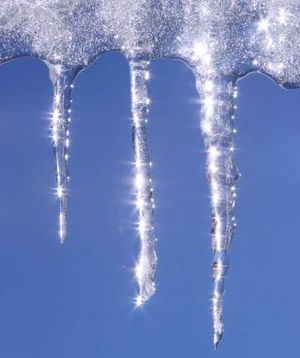Freezing facts for kids
Freezing is the process when a liquid turns into a solid. Freezing occurs when heat is lost from an object, which causes the molecules to slow down and form tighter bonds. One example of freezing is when water turns into ice. Freezing is the opposite of melting, and two steps away from evaporation. Freezing occurs at below 0 degrees Celsius with water, while some other liquids become a solid at higher or lower temperatures.
Most liquids can freeze. It is a necessary step in casting for example.
For most substances, the melting and freezing points are the same temperature; however, certain substances possess differing solid-liquid transition temperatures. For example, agar melts at 85 °C (185 °F) and solidifies from 32 °C to 40 °C (89.6 °F to 104 °F).
Contents
Crystallization
Most liquids freeze by crystallization, formation of crystalline solid from the uniform liquid.
Crystallization consists of two major events, nucleation and crystal growth. "Nucleation" is the step wherein the molecules start to gather into clusters, arranging in a defined and periodic manner that defines the crystal structure. "Crystal growth" is the subsequent growth of the nuclei that succeed in achieving the critical cluster size.
Exothermicity
Freezing is almost always an exothermic process, meaning that as liquid changes into solid, heat and pressure are released. This is often seen as counter-intuitive, since the temperature of the material does not rise during freezing, except if the liquid were supercooled. But this can be understood since heat must be continually removed from the freezing liquid or the freezing process will stop. The energy released upon freezing is a latent heat, and is known as the enthalpy of fusion and is exactly the same as the energy required to melt the same amount of the solid.
Low-temperature helium is the only known exception to the general rule. Helium-3 has a negative enthalpy of fusion at temperatures below 0.3 K. Helium-4 also has a very slightly negative enthalpy of fusion below 0.8 K. This means that, at appropriate constant pressures, heat must be added to these substances in order to freeze them.
Vitrification
Certain materials, such as glass and glycerol, may harden without crystallizing; these are called amorphous solids. Amorphous materials, as well as some polymers, do not have a freezing point, as there is no abrupt phase change at any specific temperature. Instead, there is a gradual change in their viscoelastic properties over a range of temperatures.
Freezing of living organisms
Many living organisms are able to tolerate prolonged periods of time at temperatures below the freezing point of water. Most plants, in particular, can safely reach temperatures of −4 °C to −12 °C. Certain bacteria, notably Pseudomonas syringae, produce specialized proteins that serve as potent ice nucleators, which they use to force ice formation on the surface of various fruits and plants at about −2 °C. The freezing causes injuries in the epithelia and makes the nutrients in the underlying plant tissues available to the bacteria.
Human gametes and 2-, 4- and 8-cell embryos can survive freezing and are viable for up to 10 years, a process known as cryopreservation.
Experimental attempts to freeze human beings for later revival are known as cryonics.
Food preservation
Freezing is a common method of food preservation that slows both food decay and the growth of micro-organisms. Freezing is one of the oldest and most widely used method of food preservation as far back as 1842. In freezing, flavours, smell and nutritional content most generally remain unchanged. Freezing became commercially applicable after the advent (introduction) of mechanical refrigeration. Freezing preservation is generally regarded as superior to canning and dehydration.
Related pages
See also
 In Spanish: Solidificación para niños
In Spanish: Solidificación para niños


